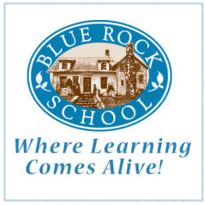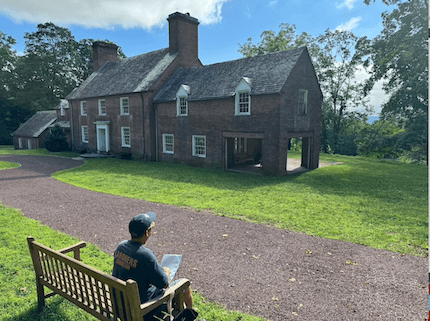 Earth Matters focuses on conservation, sustainability, recycling and healthy living. This weekly series is brought to you by The ML by Maria Luisa Scholarship fund, Strawtown Studio and Summer Play Camp at Blue Rock School.
Earth Matters focuses on conservation, sustainability, recycling and healthy living. This weekly series is brought to you by The ML by Maria Luisa Scholarship fund, Strawtown Studio and Summer Play Camp at Blue Rock School. If Earth Matters to you, sign up for our mailing list and get the next installment delivered right to your inbox.
by Susan Hellauer
It was five years ago that I first heard about the great stinkbug invasion, and saw maybe a dozen of the shield-shaped, stilt-legged little critters around my house. I bought a Bugzooka (great purchase) to suck up and contain them. Bashing stinkbugs, while satisfying, would also give the wispy, dime-size stinkers the last laugh: when crushed, they release a nauseating odor of rot that lingers long, in your home and up your nose.
No more stinkbugs have appeared since my initial Bugzooka rampage, so I was surprised to see, and read, Kathryn Schulz’s repulsively fascinating article in the March 12 edition of The New Yorker. The story opens with a beleaguered couple doing battle with 26,000 stinkbugs that moved en masse into an upstairs bedroom of their home, seeking to spend the fall and winter in a hibernation-like state called diapause before flying out in spring to eat, mate and die.
Halfway through the article I looked up from my laptop and there, as if cued by the author herself, was a brown marmorated (marbled or streaked) stink bug sitting nonchalantly on a cabinet door, just inches from my face. I grabbed the Bugzooka (which still holds vintage 2013 stinkbug carcasses) from its place behind the kitchen door, quietly pushed in the plunger, aimed, and popped the trigger. Bug gone, but not forgotten. Was he a one-off, or were his 25,999 friends hiding somewhere nearby?
The brown marmorated stink bug (BMSB) is a resilient invasive pest, with no natural enemies in our country. If they are not invading your home right now, they are on the move, and busy doing other nasty things. They won’t bite or sting you, but they can put farmers out of business, cost you money and sleep, and increase the use of broad-spectrum pesticides that cause more problems than they solve. Here’s what scientists in our region are doing right now to fight off BMSB, as well as what you can do to help them.

Halyomorpha halys, the brown marmorated stink bug (BMSB). Photo: By David R. Lance, USDA APHIS
The stinkbug hunt begins . . .
Once it was positively identified in 2001, researchers were able to trace “BMSB zero” back to its late 1990s landing in Allentown, Pennsylvania, a truck transportation hub directly connected to the ports of Newark and Philadelphia.The stowaway from Beijing, China (as DNA tests later revealed) hitched rides from Allentown to Maryland and other nearby states, where it quickly became a stomach-turning residential nuisance. In the fall of 2002, a USDA entomologist invited a team of local experts to Allentown to study the growing problem. Heading that task force was Dr. George Hamilton, now chair of the Department of Entomology at Rutgers University’s Cook Campus in New Brunswick, N.J.
As Extension Specialist in Pest Management, Hamilton regularly works with farmers, landscapers, pest management professionals and government officials on challenging bug problems. But, as he told Earth Matters, what he and his colleague saw when they got to Allentown blew their minds: “It was pretty amazing. Stinkbugs are an insect that you don’t normally see in large numbers. We were looking at crabapples and other trees, and there were hundreds of stinkbugs covering them, and all over people’s houses.” Without any natural predators to keep BMSB numbers at bay, Hamilton and his stinkbug-savvy partner feared a continuing population explosion, and an agricultural armageddon on the near horizon.

The University of Georgia’s EDDMapS invasive species tracking system shows BMSB invasions by county. Check the map for your own county’s numbers. Image courtesy University of Georgia Center for Invasive Species and Ecosystem Health
From house to farm and beyond
In 2010-2011 George Hamilton’s greatest fear was realized. Swarming stinkbugs, which feed by punching holes into a menu of over 200-and-counting fruits and vegetables like apples, Asian pears, peaches, tomatoes, corn, grapes, soybeans, caused damage to Mid-Atlantic fruit tree crops in the millions of dollars.
And that was just the appetizer. The hardy BMSB is an exceptionally good hitchhiker, arriving by the handful, and sometimes swarmful, in cars, trucks, trains, planes and travelers’ suitcases. It’s now been spotted in 44 American states [[map here]], Canada, Europe, and is still on the move worldwide. Frantic officials in farm-centric New Zealand require cars imported from the U.S., Hungary and Italy to be heated to a high temperature to kill stinkbugs on board, and they have just halted Japanese car imports after three auto-transport cargo ships were found to be filled with stinkbugs. “It’s pretty much everywhere now,” said Dr. Hamilton.
Farmers and stinkbug hunters unite
The thought of a stinkbug invasion can leave skeeved-out homeowners shaken, but fruit growers and farmers in the Hudson Valley and surrounding regions, who make their living raising some of the BMSB’s favorite dishes, are beside themselves with economic and environmental worry. The first stinkbug waves could only be held off with broad-spectrum pesticides that caused collateral damage to beneficial predators. The short term answer? More pesticides–not a good answer.
But our local farmers can turn to their own Farmers Alliance for Research and Management (F.A.R.M.), which works in partnership with Cornell University faculty and staff stationed at the Hudson Valley Research Lab (HVRL) in Highland, N.Y. (Ulster County). Cooperatively owned by regional farmers since 1963, the HVRL has been helping growers tackle problems like invasive insects, new diseases, yield issues, and the reduction of pesticide use.

An adult Trissolcus basalis female attacks an egg mass of the stink bug species Nezara viridula, similar in appearance to the eggs of brown marmorated stink bug. Several related Trissolcus species attack BMSB in its native range in Asia, and in North America. Photo by M. Roche, USDA
Director Dr. Peter Jentsch and his HVRL colleagues, who are part of Cornell University, are laser-focused on the invasive and destructive BMSB. They’re building on work being done right now at the USDA Beneficial Insects Introduction Research facility in Newark, Delaware, where scientists are studying trissolcus japonicus, a pinhead size, non-stinging Asian wasp that destroys stinkbug eggs by parasitizing them with their own eggs. This “samurai wasp” is being carefully tested in quarantine, to make sure that it will destroy only BMSB eggs in the wild, and not unravel a skein of unforeseen environmental disasters.
In a crazy bit of luck, however, some close cousins of the USDA’s samurai wasp have found their way to the U.S., likely in the same way the Chinese stinkbug did. “If a BMSB came over with its eggs, the wasp eggs could have been inside of those eggs—maybe in a shipment of plant material or something else—and then emerged and became established here in the U.S.,” said Peter Jentsch, who was happy to tell Earth Matters that these same samurai wasp cousins, first discovered in Maryland in 2015, are now fairly prevalent throughout the Mid-Atlantic states, as well as on the West Coast, Northern New Jersey and the lower Hudson Valley, where they were spotted in both 2016 and 2017. Just last week, they turned up in Ohio.

The volunteer samurai wasp is spreading into the BMSB’s range. Scientists are tracking its effectiveness in parasitizing and destroying BMSB eggs. Image: USDA stopbmsb.org
Work at the USDA lab is going well, and so are Jentsch’s efforts with F.A.R.M. to distribute volunteer samurai wasps’ eggs around 32 agricultural areas in the Hudson Valley and Western New York State. His team is carefully monitoring the wasp, and regularly counting the number of BMSB they trap. “We have a level of confidence moving forward, that this wasp is the right biocontrol agent. Because it co-evolved with BMSB, it keeps populations in Asia down to the point where BMSB is really not a primary agricultural pest there,” said Jentsch. “This is hugely important and we expect that this wasp is really going to do a fabulous job once we establish it and and get it moved into places that really need it.”
More reasons to hope . . .
In 2012 and 2013, stinkbugs did so much damage to Hudson Valley crops that growers felt that “if this kept up they’d be out of business,” said Peter Jentsch. At that point, the broad spectrum, older classes of insecticides were the only ones that proved effective against the larger BMSB. “But now there’s been a lot of work on just using perimeter sprays along the edges of orchards and crop fields, and we’ve been able to reduce our spray programs,” said Jentsch.
It appears from F.A.R.M.’s monitoring and other signs that the N.Y. State BMSB population is falling. Native predators are beginning to step up and are starting to find and destroy the BMSB’s eggs. “There are now a number of different parasitoid insects—like the samurai wasp—compared to maybe five years ago,” Jentsch said. “There’s more natural biological control starting to take place.”
And as if you need extra incentive to keep BMSB out of your home or building, forcing them to overwinter outdoors, in rock crevices or behind the bark of dead trees, gives nature a chance to do some damage. Temperatures below zero degrees Fahrenheit for two or three days can wipe out more than 90% of the population, according to Dr. Jentsch. And temperatures have fallen that low upstate during the “polar vortex” of 2014, and the recent cold snap of late December through early January. “These low temperatures, leading to natural mortality in the field, do impact the BMSB population, and cause it to decline,” he added.

While Rockland County has fewer home infestations (28) than Westchester (113), Orange (109) or Ulster County (356), there are confirmed invasions in South Nyack, Grand View on Hudson, West Nyack, Blauvelt and Valley Cottage. Check the Univ. of Georgia’s EDDMapS for county-by-county numbers across the U.S.
Defensive action and citizen science
Our experts at Rutgers, Cornell and the USDA have answers about the BMSB, and tips for residents and building owners.
Once BMSBs have left their indoor or outdoor winter hideouts in March and April, it’s time to have your building checked and all access points meticulously sealed, especially if you have seen a BMSB indoors.
Starting in late summer, carefully monitor the perimeter of your building—even if you live in an apartment—for BMSB aggregating in preparation for slipping inside. If you see them on a tree, shrub or the side of the house, contact the building owner or a pest control specialist immediately.
Home gardeners should consider non-chemical means, like row covers or netting, to control stinkbug damage to their crops. They—or any person or group—can also help reduce the BMSB population in their community by making a donation to samurai wasp research, for which they will receive a cluster of wasp eggs to set out.
Finally, if you see something, say something. In 2004, Dr. George Hamilton created a web-based citizen-science data collection project at Rutgers in order to take reports and track the spread of the nasty invader. “This helped us track its movements throughout the U.S. and up into Canada,” according to Hamilton. This system is now part of a larger Southeastern Integrated Pest Management (IPM) Center citizen-science project at the University of Georgia. If you see a BMSB, they want to know about it. Take a picture if you can, and report it online.
And that stinkbug in my kitchen? No sign of its buddies anywhere, so I asked Dr. Jentsch about it. “Check the attic,” he said. “The attic is the mother lode.” With fear and a flashlight I slowly opened the hatch. Nothing. We’ll sure fight to keep it that way.
Learn more:
- “When Twenty-Six Thousand Stinkbugs Invade Your Home” (The New Yorker, March 12, 2018)
- Frequently asked questions about the BMSB from Rutgers University New Jersey Agricultural Experiment Station
- “The Unwelcome House Guest: Brown Marmorated Stink Bug —A Guide for Residents, Property Managers, and Pest Management Professionals” (J. Gangloff-Kaufmann, New York State Integrated Pest Management Program, Cornell University)
- Dr. Peter Jentsch’s Cornell University BMSB blog page
- The USDA’s stopbmsb.org
- F.A.R.M/HVRL Youtube channel

Read Earth Matters every Wednesday in Nyack News And Views, or sign up for the Earth Matters mailing list.
Earth Matters focuses on conservation, sustainability, recycling and healthy living. This weekly series is brought to you by The ML by Maria Luisa Scholarship fund, Strawtown Studio and Summer Play Camp at Blue Rock School.











